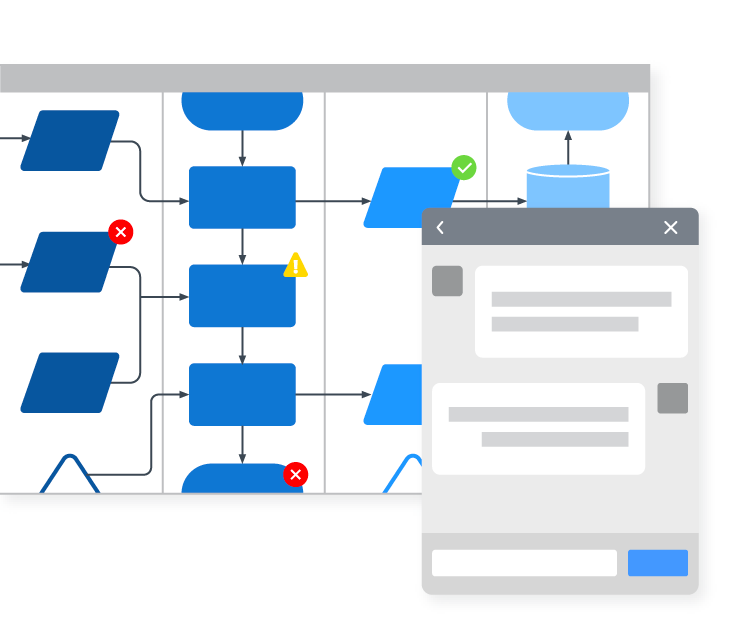A business starts with a good idea. You developed a new product. You found a way to tap into a neglected market. You created a better experience for your customers than your competitors do. Whatever your industry, whatever your business model, you have an angle.
But lots of companies that are based on great ideas don’t succeed, and only a small fraction of those that do are able to grow effectively—to scale their business. The ability to scale allows you to take a good idea and translate it into a viable business structured to meet increasing demand.
Scaling is growing, but it’s growing in the right way. It’s capitalizing on what you’ve learned and learning from others in order to grow your business smarter. Whether you’re trying to build your startup or turn a large local company into a national brand, there are simple, often ready-made steps you can take to build a scalable business.
What is scaling in business? What is growth?
Let’s start by defining our terms. Growing your business is obvious enough: Your business has increased its revenue through expansion or other methods. If your restaurant is doing well and you add a second location, your business is growing. If you sign a contract to sell your product at a big retailer, your business is growing. If your agency signs a new client, your business is growing.
If your costs are growing as fast as your revenue, you’re not scaling. But what is scalability? Scaling a business means increasing your output and revenue more quickly than your effort and costs. And while some elements of your business are directly correlated to your size (you’ll need approximately the same number of servers at your second restaurant location), many are not (you probably don’t need twice as many HR professionals to handle the staff).
When to scale your business
So if scaling is defined broadly as streamlining operations and planning for healthy growth, every company is ready to scale, though the steps you take vary depending on where your business is in its lifecycle.
First, it’s never too early to start planning for the future. In fact, planning may be the only appropriate scaling step for early-stage startups, because trying to grow too quickly can overextend a promising business.
So as you’re working hard on the day-to-day aspects of getting started, schedule time to step back and think strategically. Imagine what you want your business to look like in six months, or a year, or five years, and think about whether the processes you’re putting in place now are set to accommodate that future. Pick a few key areas to invest in the right solution instead of the cheapest one.
No matter how mature your business is, it’s helpful to step back and look hard at current bottlenecks and anticipate ones on the horizon. Hiring takes time. Branding and marketing take time. Training takes time. Market research takes time. Get out in front of time-intensive operations so the rest of your business isn’t stalled while you scramble to catch up.
Scaling has to happen throughout your company’s growth stages. There’s no backdating it after you run into a problem. Study the present to see into the future. As they say, an ounce of prevention is worth a pound of cure.
How to scale your business
Just as scaling looks different depending on what stage you’re in, the specific steps you take will depend on your industry, your market, and your goals. But there are four general scaling principles that apply to just about any business looking to grow strategically.
1. Improve your processes
First, standardize as much as you can. Every department doesn’t need its own hiring process, its own performance review, its own email signature. Don’t reinvent the wheel. Keeping things uniform not only makes you more efficient, but it can also reinforce your company’s brand and help create a cohesive culture.
Second, document your processes. The oral tradition is great for storytelling, but it’ll serve your business to put important procedures in writing. How is the company structured? What is the process for professional development? What are the brand guidelines? Is there a dress code? Eliminate the guesswork and let your employees know what’s expected from them.
Third, automate your workflows. Micromanagers, step back. From payroll to workflow to customer support to social media, there’s an option to automate it, and it probably costs less than you think.
The goal of these steps is to let each employee spend more time doing what they were hired to do and less time sorting through ancillary logistics. Ask around for ideas. Inside and outside.

Get additional ideas on how you can streamline your processes to improve efficiency.
Read now2. Create a single source of truth
When your business is small, you can get away with being a little disorganized. It’s not ideal, obviously, but if there are only a few people running the show—and they’re available—you can probably get the answers you need with a phone call.
But once your business grows beyond a handful of employees, it’s essential to have all your business data and documentation stored in one place, not floating around in various people’s inboxes.
Find a solution that makes all your vital documents accessible to the people who need them. And part of accessibility is organization—if it’s stored on a server or in the cloud but you can’t find it, it might as well not be there. Every minute you spend centralizing and organizing your business’s data will save you hours down the road that you would have spent chasing things down or recreating them altogether.
3. Invest in technology that improves communication
Slack has changed how we talk to each other. Email platforms have gotten more sophisticated. Project management software keeps everything transparent and accountable. Communication—between teammates, between teams, with customers—is the lifeblood of a business, so streamlining the way we talk is a powerful way to optimize output.
Decide on your communication priorities, invest in the right technology (or technologies, though the more you can integrate your systems the better), and make sure everyone’s bought in.
4. Facilitate remote employees and dispersed offices
More and more employees are coming to appreciate—and even expect—the option to telecommute, and in many ways the workplaces that offer it are just catching up with the world around them. (How long have we been shopping, socializing and watching our movies online?)
Remote work holds the potential to benefit the business as well. For one, you can cut down on overhead and lease a smaller office space if a significant number of your employees work from home.
Another benefit is that you can cast a wider net to find talent. Maybe your office is in Iowa but the perfect analyst lives in Minneapolis. It’s not a problem if you’ve structured your business to enable remote employment. Improved communication also allows you to establish satellite offices in locations specific to your business needs that can still connect easily with headquarters and other offices.

FREE GUIDE
The shift to remote employees can present challenges to company culture. Learn how to adapt and better manage these team members.
See our 6 tipsBusiness scalability is about planning, perspective, and balance. Be rigorous and transparent about your processes. Ask your employees about the pain points of their jobs. Study what your competitors are doing, for better or worse. Take a problem to a colleague and see if he or she has a solution you hadn’t thought of.
All of these scaling principles are organized around allowing you to focus your energy on what matters and delegate your business operations strategically, so you can grow your business the right way.

Nail it before you scale it. See how Lucidchart can help you optimize processes and maintain a single source of truth as your business grows.
Learn moreAbout Lucidchart
Lucidchart, a cloud-based intelligent diagramming application, is a core component of Lucid Software's Visual Collaboration Suite. This intuitive, cloud-based solution empowers teams to collaborate in real-time to build flowcharts, mockups, UML diagrams, customer journey maps, and more. Lucidchart propels teams forward to build the future faster. Lucid is proud to serve top businesses around the world, including customers such as Google, GE, and NBC Universal, and 99% of the Fortune 500. Lucid partners with industry leaders, including Google, Atlassian, and Microsoft. Since its founding, Lucid has received numerous awards for its products, business, and workplace culture. For more information, visit lucidchart.com.

